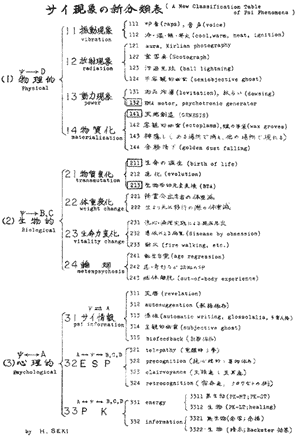関英男 *
The method of studying psi phenomena may be considered in many ways. But, it is unexpectedly useful to consider all psi phenomena as a whole and to draw underlying principle behind them. From thi8 standpoint, an improvement of the classification table of all psi phenomena was undertaken by the author since 1970. He published the first table on 12 July, 1973. It was revised several times since then. The latest one has been published on the "PSI JOHO", the popular Journal of our PS lnstitute of Japan.
Speaking of the classification table, Dr. Rhine has studied the following fields of parapsychology (1) as: -
 |
32 ESP |  |
321 telepathy |
| 322 precongnition | |||
| 323 clairvoyance | |||
| 331 PK |  |
3311 PK-MT | |
| 3311 PK-ST | |||
| 3312 PK-LT |
At the Second lnternational conference on Psychotronics in Monaco, the definition of "psychotronics" was given(2),1.e.
"a science which in an interdisciplinary fassion studies fields of interaction between people and their environment both internal and external and energetic process involved. Psychotronics recognizes that matter, energy and consciousness are interrelated. The study of this interconnectioltributes to the new understanding of the energetic capablilties of the human being like processes and matter in general."
Though l would not like to discuss more in detail, the study fields of psychotronics seems to be similar to that of parapsychology with very little nuance.
The author would like to point out again more important fields which were not implied in parapsychology or psychotronics. The phenomena can occur without the intentional mind of human being. He classified them into (1) Physical and (2) Biological phenomena. According to his hypothesis, these phenomena can occur under the influence of ψ information systems, though the latter are not limited to une kind in their complexity and in the degree of sophistication. ln the past, more of these phenomena were treated in the fields of psychic research as the phenomena due to the spirits of dead people. However, there are many phenomena which were orere originated by the ψ information systems of higher order. 141 and 211 are two examples. 0n the other hand, ψ information systems of the lower order also cause some phenomena which were not taken up in psychical research. 132 and 213 belong to this category, ln short, (1) and (2) include more than the fields of socalled psychics.
Finaly, in classifying 33 PK, energy and information were conveniently used, in soite of no purely energy-oriented nor purely information-oriented PK phenomena being existea. For example, 331 energy means that energy-orientation is rlatively larger than information-oriantation and vice versa for 332. Some symbols in the table may need explanations as follows: -
A: active person of psi phenomena
B: passive person of psi phenomena
C: passive living things of psi phenomena
D: passive inanimate object of psi phenomena
ψ : psi information system
EMA: Electro-Magnetic Association
BTA: Biological Transmutation of Atom
143: mysterious disappearance (to be spirited away at one place and to appear at another place)
221: weight decrease due to extraction of ektoplasm
222: weight deorease at the moment of death
231: health and happiness by mind setting and ethical practicing
242: birthmark or malformation to prove former life
3321: Inanimate objects (thoughtgrapby; thoughtscript )
a. 分類表作製の経緯
「サイ情報」の創刊号(1976.12.5)の巻頭に発表した。何を改めて再発表の必要があろうかとの疑問も当然のことである。当時の表の下に、絶えず訂正していますので、ご意見をお寄せ下さい、と記しておいたが、今日まで特別のご意見はなかった。実の所この表はサイ科学の全貌を表し、超心理学や心霊科学との関係を知る上で非常に大切な意味をもっていたのであるが、その点を少しも説明せずに、表だけお見せした所に手抜かりがあった。
筆者はこの表についてハワイ大学当時から構想を練り、帰国するとすぐ「情報科学」誌1973年4月号に発表した。それとほゞ同じものを電通大西II号館6階会議室における同年7月12日の小会合で発表した。実は前記「サイ情報」の創刊号に発表したものはこれを大巾に改良したつもりのものであった。 それでもまだ、すっきりしない所が残っていた。その後ずっと考察を続け、とうとう今度は完璧に近いものができ上がったような気がしている。結局前後約10年の歳月を費やしたことになる。そこで折角の機会だから、外国の同好の士に示すつもりで英文の内容梗概を多少長めに書いてみた。
b. 超心理学のそれとの比較
アメリカ近代超心理学の父として有名なライン博士がデューク大学付属超心理学研究所の研究内容を分類した表(1)は次のようなものである。
 |
32 ESP |  |
321 テレパシー |
| 322 予知 | |||
| 323 透視 | |||
| 331 PK |  |
3311 PK-MT(運動体に作用) | |
| 3311 PK-ST(静止体に作用) | |||
| 3312 PK-LT(生物に作用) |
これは今回の表の約1/6位にしか相当しない。かりに324の脱落を大目にみても、大きいのは31のサイ情報である。これはψ情報系と人間との関係を問題にする点で大切な現象であるからである。多分、人間と人間との間の相互作用だけに注目したゝめに、ψと人間との間の相互作用を落としたものと想像する。それにしても人間と人間との間の相互作用にも中間にψ情報系が存在しなければならないことを考えれば、当然気づいてもよさそうなことである。
さて、第2回ICPR(1975)で発表されたサイコトロニクスの定義(2)をPSIJ月報3号でみても分かるように、この分類表の33に重点があり、32に付随的に考える程度である。それゆえ、上記の超心理学の範囲と大きい開きを見出せない。
c. 心霊科学の位置づけ
在来の超心理学は心理学の延長上にあるから、人間の心理現象を取り扱うのは当然としても、サイ現象に中には人間の意志に原因しないとみられるものも相当部分ある。これらを今回の表では(1)物理的(2)生物的として分類した。約言すればψ情報系より物質に作用して起るサイ現象を(1)、生物に作用して起るサイ現象を(2)に含めた。
英米両国において100年以上の伝統を誇る心霊科学はほとんど(1)と(2)の領域にあるとみてよい。心霊科学の定義は“霊魂によってひき起される現象を心霊現象といい、心霊現象を霊界の事象を系統的に研究整理して一般法則を見出し、これを応用する学問を心霊科学といいう”(3)であるから、これもサイ現象の全部を包含してはいないことになる。なぜなら、サイ現象はサイ情報系によってひき起される現象であり、霊魂だけがサイ情報系のすべてではないからである。この論文はサイ情報系の詳細に立入るのが主眼でないが、最低より最高までいろいろな段階のサイ情報系があり、それらの情報量の開きは少くとも10100ビット以上に及ぶと想像される。最高級程度のそれによるサイ現象の例は141の天地創造とか211の生命の誕生とかである。低い方の例は132や213等である。
d. 二三の注意
催眠術をどこに入れるかとの疑問もあろうが、これはテクニックであってサイ現象そのものではない。催眠現象といえないこともないが、これはASCの一種である。
UFOは多くのサイ現象を内包した環境とみるべきであって、一つのサイ現象として表に入れるには複雑すぎる。
PKの影響はエネルギー(E)と情報(I)の合成として考える。しかし、便宜上、E>>Iの場合331、I>>Eの場合332とした。
e. むすび
約10年にわたる検討の結果をお目にかけた。御講演や御研究に利用して下さると有難い。項目の内容については本誌各号末の「述語解説」等でご承知願えると思う。
参考文献
(1)Interview: Dr.J.B.Rhine, Psychic Vol. III,
N0.6, July 1972, pp.7-34
(2)Stanley Krippner: Psychotronic and
the Study of Human Personality, read at
the Second ICPR, Monte Carlo, Monaco
1975 「サイ科学」創刊号に全訳掲載
(3)板屋 樹、宮沢虎雄:霊魂の世界、心霊科学入門
日本心霊科学協会発行 (1971.3.25)
